Sporle, Norfolk (†Norwich) c.1400
The Life of St Catherine
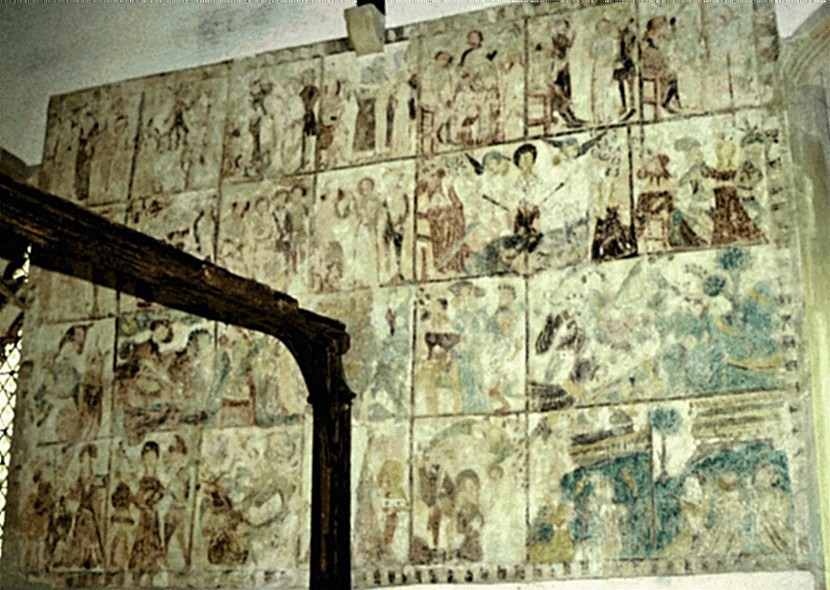
At the left in its entirety is the very large Sporle Life of St Catherine, badly damaged¹ and blurred in parts but still the fullest treatment of the subject in English wallpainting. It tells the story of Catherine’s martyrdom from her summoning to Alexandria by the Emperor Maximus II to the aftermath of her death and burial, with pilgrims visiting her tomb. The various scenes, from top left to bottom right, are pictured and described below.
First, Catherine arrives at the court of Maximus, who has heard of her great learning. There are at least three figures in this scene (left, below) – Catherine herself, the Emperor or his representative, and Catherine’s father, the king of Cyprus. In the next scene to the right, the Emperor has ordered sacrifice to a pagan idol, shown centrally as a black, devilish figure with a twisted tail. The devil-idol is mounted on a pillar which has now disappeared, along with most of the details of worshipping figures clustering around it.

The next scene shows Catherine, another figure probably meant for an escort or guard beside her, talking with the Emperor, who is seated at the left, and in the next scene to the right, scholars and wise men are brought to hear her discourse on
 religion and philosophy. The remaining scenes in this top tier are shown at the right, with Catherine addressing the fifty philosophers brought to hear her. The philosophers are grouped in the centre, with Catherine standing on the right and the Emperor seated at the left. In the next two scenes in this tier, Catherine, having converted the philosophers to Christianity, is brought before the Emperor and condemned. In the third tier (below left), she
religion and philosophy. The remaining scenes in this top tier are shown at the right, with Catherine addressing the fifty philosophers brought to hear her. The philosophers are grouped in the centre, with Catherine standing on the right and the Emperor seated at the left. In the next two scenes in this tier, Catherine, having converted the philosophers to Christianity, is brought before the Emperor and condemned. In the third tier (below left), she
![Life of St Catherine, detail]](images/sporcat.jpg) is put in prison, where she converts the sympathetic Empress to Christianity. These scenes are very faded and confusing, but in them Catherine is brought before the Emperor again, sentenced to be scourged, and this time to be broken on the wheel. The remaining scenes in this tier (below right) show the saint fastened to the wheel, almost all of which has gone, with the
is put in prison, where she converts the sympathetic Empress to Christianity. These scenes are very faded and confusing, but in them Catherine is brought before the Emperor again, sentenced to be scourged, and this time to be broken on the wheel. The remaining scenes in this tier (below right) show the saint fastened to the wheel, almost all of which has gone, with the
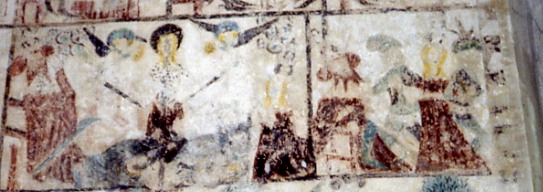 Emperor seated at the left again. But the attempt to kill Catherine fails as two hovering angels intervene and the wheel fractures and/or ignites, possibly wounding the Emperor, who raises a hand to his face, while the yellow-haired Empress, now Catherine’s ally, kneels at the right. In the final scene, the Empress is dragged before her husband, rebukes him for his cruelty, and is herself condemned to be beheaded.
Emperor seated at the left again. But the attempt to kill Catherine fails as two hovering angels intervene and the wheel fractures and/or ignites, possibly wounding the Emperor, who raises a hand to his face, while the yellow-haired Empress, now Catherine’s ally, kneels at the right. In the final scene, the Empress is dragged before her husband, rebukes him for his cruelty, and is herself condemned to be beheaded.
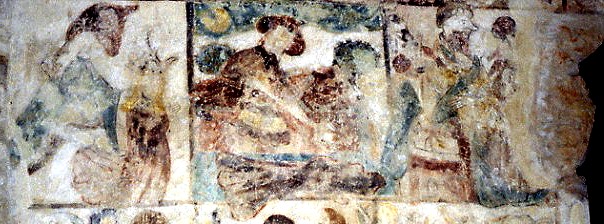
The fourth tier (below left) has some very rare scenes indeed. First, the Empress kneels, awaiting decapitation, and in the next scene the keeper of the prison buries her by moonlight (the moon itself is clear, shown as a yellow disc against the dark blue night sky). The next scene is believed to represent the Emperor’s condemnation of the prison guard, and the next after that (below, right) shows the passing of the death sentence on the prison keeper, who is probably the pale blue figure standing in the centre. Since by now Catherine has converted almost everyone surrounding the Emperor, a general massacre of Christian soldiers is shown in the final scene in this tier. Raised arms brandishing swords predominate, but there are two figures, one semi-recumbent and obviously fallen, at the left, and a stylised branching tree at the right.

One final tier, completing Catherine’s story, remains. The lower left section, shown here at the left, deals with her final arrest and condemnation. At the far left, Catherine is again before the seated Emperor, her hands held out before her in protest, and the next scene, where she is seized by the executioners, is a good example of the way in which medieval painters conveyed the idea of moral depravity
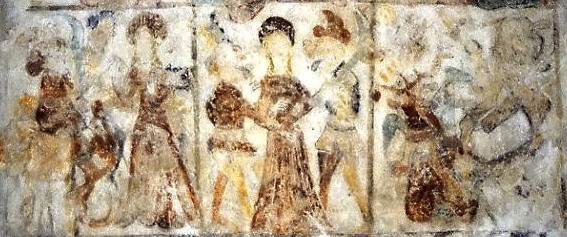 or sadistic coarseness. The faces of the executioners are suitably grotesque and ill-formed, like ‘those which in old hangings whip Christ’, as John Donne had it², or those who are shown in the Crucifixion scenes at North Cove. Both executioners stick out their tongues at Catherine, a gesture of derision found fairly frequently. The scene following this is said to show devils contending for Catherine’s soul in advance of her death, and clearly there is some fairly intense activity going on here, but it is difficult to identify the jumbled shapes now.
or sadistic coarseness. The faces of the executioners are suitably grotesque and ill-formed, like ‘those which in old hangings whip Christ’, as John Donne had it², or those who are shown in the Crucifixion scenes at North Cove. Both executioners stick out their tongues at Catherine, a gesture of derision found fairly frequently. The scene following this is said to show devils contending for Catherine’s soul in advance of her death, and clearly there is some fairly intense activity going on here, but it is difficult to identify the jumbled shapes now.
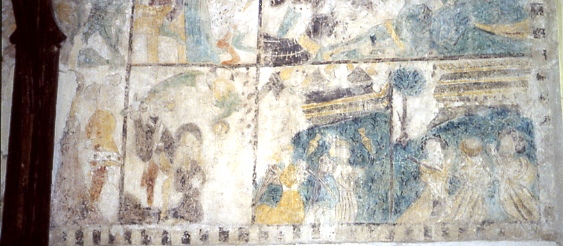
The final scenes – those that more than any others make this painting remarkable – are unfortunately some of the most damaged. At the far left below and partly obscured by the remains of a parclose screen that once led into St Luke’s chapel, is part of a scene showing Catherine led off to her death. To the right of this she is shown kneeling as the executioner raises his sword while an angel waits at the upper right of the scene. Finally, angels take the saint’s body to her tomb on Mount Sinai (shown as a yellow and black rectangular structure with a dark grey dome at the top of this panel). In the lower part of the scene you may be able to make out the figure of the white-clad and haloed Catherine, flanked by two angels swinging censers. In the last scene of all, three pilgrims, the central one with a tonsure, I think, are shown in reverence at Catherine’s tomb.
This must be one of the most comprehensive saints’ lives painted anywhere, and it is certainly unique in the English parish church. The water damage is all the more to be regretted.
¹ Vandalism to the roof in recent years allowed water to penetrate, making the colours ‘run’ and blurring them beyond remedy in many areas.
² In Satire IV, lines 225-226